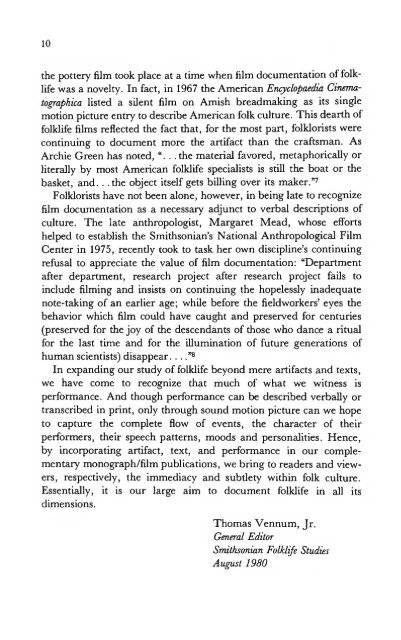Smithsonian Contributions - Smithsonian Institution Libraries
Smithsonian Contributions - Smithsonian Institution Libraries
Smithsonian Contributions - Smithsonian Institution Libraries
You also want an ePaper? Increase the reach of your titles
YUMPU automatically turns print PDFs into web optimized ePapers that Google loves.
10<br />
the pottery film took place at a time when film documentation of folklife<br />
was a novelty. In fact, in 1967 the American Encyclopaedia Cinematographica<br />
listed a silent film on Amish breadmaking as its single<br />
motion picture entry to describe American folk culture. This dearth of<br />
folklife films reflected the fact that, for the most part, folklorists were<br />
continuing to document more the artifact than the craftsman. As<br />
Archie Green has noted, "... the material favored, metaphorically or<br />
literally by most American folklife specialists is still the boat or the<br />
basket, and. . .the object itself gets billing over its maker." 7<br />
Folklorists have not been alone, however, in being late to recognize<br />
film documentation as a necessary adjunct to verbal descriptions of<br />
culture. The late anthropologist, Margaret Mead, whose efforts<br />
helped to establish the <strong>Smithsonian</strong>'s National Anthropological Film<br />
Center in 1975, recendy took to task her own discipline's continuing<br />
refusal to appreciate the value of film documentation: "Department<br />
after department, research project after research project fails to<br />
include filming and insists on continuing the hopelessly inadequate<br />
note-taking of an earlier age; while before the fieldworkers' eyes the<br />
behavior which film could have caught and preserved for centuries<br />
(preserved for the joy of the descendants of those who dance a ritual<br />
for the last time and for the illumination of future generations of<br />
human scientists) disappear. . . ." 8<br />
In expanding our study of folklife beyond mere artifacts and texts,<br />
we have come to recognize that much of what we witness is<br />
performance. And though performance can be described verbally or<br />
transcribed in print, only through sound motion picture can we hope<br />
to capture the complete flow of events, the character of their<br />
performers, their speech patterns, moods and personalities. Hence,<br />
by incorporating artifact, text, and performance in our complementary<br />
monograph/film publications, we bring to readers and viewers,<br />
respectively, the immediacy and subtlety within folk culture.<br />
Essentially, it is our large aim to document folklife in all its<br />
dimensions.<br />
Thomas Vennum, Jr.<br />
General Editor<br />
<strong>Smithsonian</strong> Folklife Studies<br />
August 1980

















